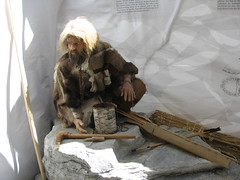Ötzi the Iceman (also spelled Oetzi): a well-preserved natural mummy of a man from about 3300 BC,[1] found in 1991 in the Schnalstal glacier in the Ötztal Alps, on the border between Austria and Italy. The nickname comes from Ötztal, the region in which he was discovered, says Wikipedia.
He is Europe's oldest natural human mummy, and has offered an unprecedented view of Chalcolithic (Copper Age) Europeans.
Since 1998 it has been on display at the South Tyrol Museum of Archaeology in Bolzano, Italy.
At the time of his death, Ötzi was approximately 5 ft. 4 in.) tall, and about 30 years of age. Because the body was covered in ice shortly after his death it only partially deteriorated.
Analysis of pollen and dust grains and the isotopic composition of his tooth enamel indicate that he spent his childhood near the present village of Velturno, north of Bolzano, but later went to live in valleys about 50 km further north.
Analysis of Ötzi's intestinal contents showed two meals (the last one about eight hours before his death), one of chamois meat, the other of red deer meat. Both were eaten with some grain as well as some roots and fruits. The grain from both meals was a highly processed einkorn wheat bran, quite possibly eaten in the form of bread. There were also a few kernels of sloes (small plum-like fruits of the blackthorn tree).
Pollen in the first meal showed that it had been consumed in a mid-altitude conifer forest, and other pollens indicated the presence of wheat and legumes, which may have been domesticated crops. Also, pollen grains of hop-hornbeam were discovered. The pollen was very well preserved with even the cells inside still intact, indicating that it had been fresh (a few hours old) at the time of Ötzi's death. This find places the event in the spring. Interestingly, einkorn wheat is harvested in the late summer, and sloes in the autumn; these must have been stored since the year before.
High levels of both copper particles and arsenic were found in Ötzi's hair. This, along with Ötzi's copper axe which is 99.7% pure copper, has led scientists to speculate that Ötzi was involved in copper smelting.
He apparently had whipworm (Trichuris trichiura), an intestinal parasite.
He had approximately 52 tattoos consisting of simple dots and lines. The designs might have been used to mark the passage from youth to manhood,[citation needed] or it has been speculated that they may be related to acupuncture.
Ötzi's clothes, which included a woven grass cloak and leather vest and shoes, were quite sophisticated. The shoes were waterproof and wide, seemingly designed for walking across the snow; they were constructed using bearskin for the soles, deer hide for top panels, and a netting made of tree bark. Soft grass went around the foot and in the shoe and functioned like warm socks.
The shoes have since been reproduced by experts and found to constitute such excellent footwear that there are plans for commercial production.[6] However, a more recent theory by British archaeologist Jacqui Wood says that Ötzi's "shoes" were actually the upper part of snowshoes. According to this theory, the item currently interpreted as part of a backpack is actually the wood frame and netting of one snowshoe and animal hide to cover the torso.
Other items found with the Iceman were a copper axe with a yew handle, a flint knife with an ash handle, a quiver of 14 bone-tipped arrows with viburnum and dogwood shafts and flint heads (two arrows were finished, twelve were not), and an unfinished yew longbow that was 3 feet 2 inches (one metre) tall.[7] Also found were berries, a bucket and a knife.
Among Ötzi's possessions were two species of polypore mushrooms with leather strings through them. One of these (the birch fungus) is known to have antibacterial properties, and was likely used for medicinal purposes. The other was a type of tinder fungus, included with part of what appeared to be a complex firestarting kit. The kit featured pieces of over a dozen different plants, in addition to flint and pyrite for creating sparks.
A CAT scan revealed that Ötzi had what appeared to be an arrowhead lodged in one shoulder when he died, matching a small tear on his coat. The arrow shaft had been removed, apparently by a companion. He also had bruises and cuts on his hands, wrists, and chest. DNA analysis revealed traces of blood from four other people on his gear: one from his knife, two from the same arrowhead, and a fourth from his coat.
This may indicate that Otzi was actually part of an armed raiding party, and had gotten into a skirmish, probably with a neighboring tribe, and this skirmish had gone badly for the attackers.
The biological evidence suggests that he was out of his home territory. The DNA evidence suggests that he was assisted by companions who were also wounded. The repairs he had made to his clothing are very crude compared to the original stitching. The copper axe could not have been made by him alone. It would have required a concerted group tribal effort to mine, smelt and cast the copper axe head. This all shows foresight, planning and preparation on a large scale with a certain goal in mind.
Subscribe to:
Post Comments (Atom)


No comments:
Post a Comment